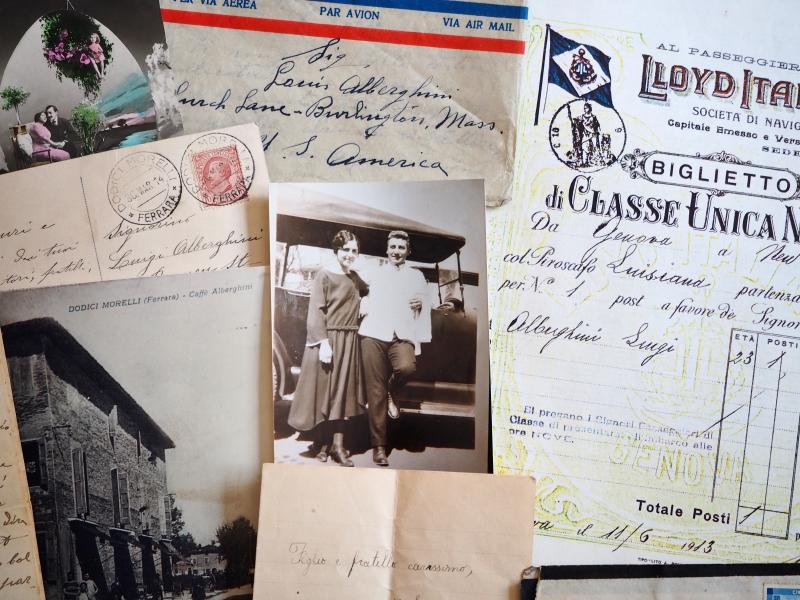For our series ‘Back to Your Italian Roots,’ where we share stories of readers who have traveled to Italy to reconnect with relatives and visit their ancestral towns, we’ve talked to Laura Ventimiglia, whose grandparents emigrated to America from two tiny villages in the province of Cento in the early 1900s, Renazzo and Dodici Morelli.
Laura didn’t become fully aware of her Italian roots until she married a Sicilian-American. Noticing how her approach to discipline and education differed from her husband, who was raised in a Sicilian family in a largely Sicilian-American community in Massachussetts, Laura decided it would be important to understand the ways in which her Italian heritage shaped her identity and life, and in turn would influence her children’s upbringing. In college, she focused her studies on Italian heritage and culture, incorporating her family history. Her thesis eventually became a book, “A Letter To My Children: An Italian-American Family’s Heritage,” published in 2016, after Laura had begun traveling to Emilia-Romagna to reconnect with her relatives there. Laura founded her own publishing imprint company, Buttieri Press, hoping to inspire more people to look for and celebrate the heritage of their families.
Her work in this field has also led to a collaboration with the Historical Archive in Cento for the creation of an online museum, Nulla osta per il mondo, whose purpose is to help people learn about their family history, both for Americans searching for their Italian ancestors and Italians in the Cento district looking for their ancestors who immigrated to America, to help relatives find each other and make lasting connections. “This recognizes that each - Americans and Italians - lost some of their heritage when people immigrated to America and other countries,” Laura says.
Laura, what prompted you to begin your search to trace your Italian roots?
Searching was one way to avoid a brewing catastrophe. You see my husband, Frank, and I had been married 15 years. Life was fun but crazy with five children under the age of ten. His entire family was from Sicily. The Italian side of my family was from Emilia-Romagna in Northern Italy. These two different worlds were crashing down around our children. Our core value of family was the same. Yet, the cultural differences between our families were very noticeable. Take family gatherings for example. Our children were greeted by personalities that ranged from the Northern church mouse to the larger-than-life Sicilian. Their ears were treated to corresponding decibels along the sound spectrum. The effects of these not-so-subtle differences were perceptible. I thought we could really mess these kids up if we didn’t figure it out.
In 1985, I was starting the last semester of my undergraduate college program. I thought this might be a good opportunity to learn about the history and culture of Italy as a way to understand our Italian heritages. My professor suggested I incorporate a family history search into my studies. At the same time, connections to my past were disappearing. My Nonna and Nonno, Maria Govoni and Luigi Alberghini, who didn’t talk about their lives in Italy, were dead. My Aunt Alma recently passed away. I knew I didn’t have much time before others would be gone too. So, I poked around and suddenly I was hooked!

[Laura Ventimiglia in front of her grandmother's house.]
Please describe the process. Did you already know your ancestral town? If not, how did you find it? Who or what was your first resource when you started your search for your ancestral town and Italian relatives?
I became fanatical in learning about my family’s history. It was before the time of online services. My best resources were books on Italian genealogy, genealogy societies, resource rooms, and people, especially people. I asked questions of anyone who would listen; questions I hadn’t thought of when my grandparents were alive. I drove everyone around me crazy. My enthusiasm paid off. As people heard of my quest, they jumped in to help. Several gems emerged. My Aunt Irma arranged for me to meet my grandfather’s 102-year-old friend, Gus. A lively gentle man, he and my Nonno were from the same town of Dodici Morelli. His nimble memory provided detailed descriptions of life there and of my grandfather’s family. A conversation around a dinner table with several great aunts and a great uncle provided tips that helped me track down Elena, my grandfather’s second cousin. She frequently visited family in Italy. When I met Elena, a gracious elegant woman, she brought to life the town of Renazzo. She offered amazing descriptions of my grandfather’s relatives, his ancestral home, and the woman he would meet and marry, my Nonna. Additionally, old family photographs and over 200 letters and documents dating back to 1908 were found throughout my grandparents’ house long after they were gone. Thankfully my father, Louis, saved these treasures. I became engulfed in my past.
But, all this searching was done in America. For 30 more years I dreamed of going to Italy, visiting my ancestral towns, walking the streets my ancestors walked, connecting with them in spirit. I never imagined relatives could still be living there in the neighboring towns of Renazzo and Dodici Morelli in the District of Cento, Province of Ferrara, Region of Emilia Romagna.
What were the obstacles, if any, during the process of finding your relatives and then getting in touch?
Although my research produced the names of my grandparents’ hometowns, some photos, and ancestor names, we didn’t actually know anyone in Italy. In 2013 my sister, Lisa, had an opportunity and an idea. She and her husband, Pete, traveled to Italy on a spur of the moment trip. When they landed in Rome she emailed me for information. She hoped to visit the hometowns of our ancestors and look for relatives. I sent her a set of pictures and names. Lisa arrived in Renazzo with only these clues. She stopped people in the streets and asked. She rang the door buzzer at the first house they saw. The door opened. Raffaella, a short woman in her seventies smiled at them. Lisa pointed to the photo of our great grandmother, Maria Rosa Ranieri. “This is my Nonna.” Raffaella recognized the woman in the picture. Speaking only Italian, she welcomed them into her home. Not speaking each other’s language, there was a hasty search for a relative who spoke a little English. Finally, Alfredo arrived and by the end of their two-hour visit, they agreed – we were related.
A few months later, my brother, John, and his wife, Cheryl, went to Renazzo. They spent two wonderful days there. John, a methodically inquisitive guy, went a bit more prepared. He had genealogy charts and copies of photographs also from my research. He and Cheryl received the same welcoming treatment and were greeted with a huge family dinner. Seated around the table were more than 20 relatives. A few younger cousins fortunately spoke English. During dinner the conversation turned to how our families were related. Francesco, a young engineering student, jumped up and ran to the computer. He charted out, with everyone’s input, their family and ours. John came back with one message: Laura, you have to go!
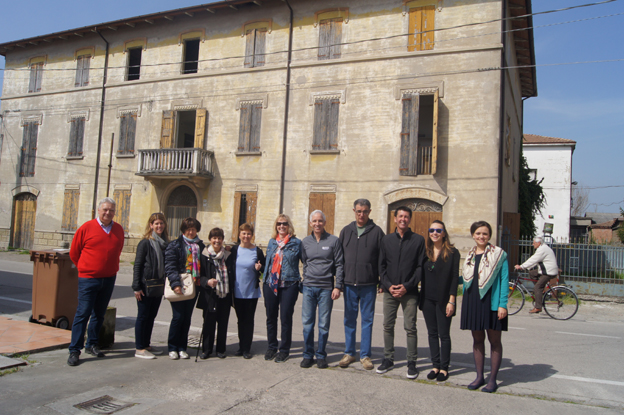
[Laura with her family from Emilia-Romagna in front of her grandfather's house.]
Please describe the moment when you first met your Italian relatives.
My thirty-year old dream was about to come true. Frank and I drove into Renazzo in November 2014. I couldn’t wait. I wanted to blink my eyes and have my ancestral home appear. I started to panic as the GPS was taking us in what appeared to be all the wrong directions. Finally, we were there. I pressed the door buzzer on the home where my great-grandmother was born. I was excited and apprehensive at the same time. Okay, mostly apprehensive. I only knew a few Italian words – ciao, buongiorno, grazie, arrivederci – spoken with a true Boston accent. And, I didn’t know what I didn’t know about Italian culture such as asking permission – permesso – to enter someone’s home. Most importantly, I wondered – would they like me? I stood there nervously twitching yet trying to remain calm.
When the door opened, a young Diletta greeted us with a brilliant smile. She ushered us in to a very long hallway. Everyone and everything blurred to my emotionally teary eyes. Adrenaline pumped through my body. The humming in my ears deafened me to the introductions. Eventually my anxiousness subsided to know that we were meeting cousins on the side of my Nonno’s mother, Maria Rosa: Raffaella and her husband, Franco; Giovanni, their son; and, his twin daughters Alicia and Diletta who fortunately for us, are multi-lingual. That first visit was incredible! I was beyond happy then and during our whole trip! Initially, we hoped to see my newly found relatives two or three times during our seven-day stay in Renazzo. Instead we spent each day with them from 9am till 9pm or later. By the time we left, we had attended several large family dinners and met more than 45 cousins. Frank and I were ecstatic. The trip was fantastico!
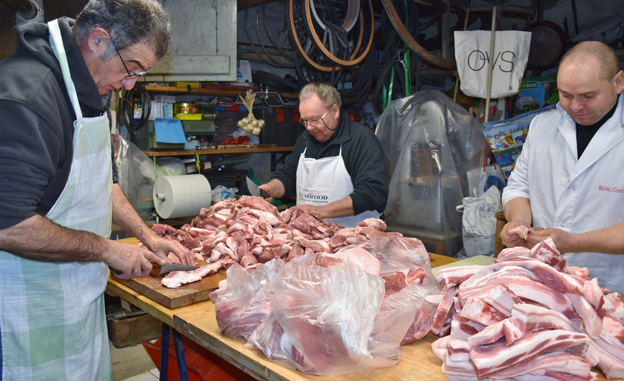
[Making salami with family in Emilia-Romagna.]
Please describe how you felt the first time you walked the streets of your ancestral town.
Surreal is how I describe walking the streets of my ancestors when I first arrived and every time I visit. Two particularly poignant experiences stand out. The first was during my initial trip to Renazzo. Walking towards the house of my Nonna and her parents, Carlo Govoni and Laura Ardizzoni, I imagined life in the 1890s. Today, though, the house was vacant and shuttered. When I arrived, I walked tenderly around it. I reached out and touched its bricks, doors, windows. I felt the history of my past. I started out, then, walking away from it. I retraced the steps Nonna would take to go to the town’s grocery store. Following the path of the dirt road, I intended to walk along the streets. Suddenly, as if by some supernatural force, my head snapped in the direction of the store. I saw in my mind instead the route she would take. I followed her. Veering off the road I ran, as a child would, diagonally across what would have been open farmland until I envisioned arriving at the store of her time. My Nonno’s grandparents owned that store. It was where Nonna would see him when he visited from Dodici Morelli. See him but never meet him. They only met each other in America when they were adults.
My second experience was the following year in Dodici Morelli. We were on a tour of the property owned by my Nonno’s family. They had five buildings central to the town’s life and economy. Cousin Fabio, a resident of Dodici Morelli, a history buff and our tour guide even arranged for us to go inside one of the buildings. It had been empty for years but was still very much in its original design from the turn of the 20th century. Our group included an American contingent – Frank and I, my brother John and his wife Cheryl, my cousins Tom and Maria, their mother, my Aunt Irma – with Diletta and Alicia, the town photographer, Giancarlo, and his sister, Ivonne. Irma and I have always had a special relationship. She is 92 years of age, active and has an excellent memory. She is a tremendous resource in my research. Rather than talk about and imagine Nonno’s life in Italy, we experienced a bit of it first-hand. Sharing that journey back in time with her was especially moving.
Any fun anecdotes upon meeting your Italian relatives?
During our first evening in Renazzo we encountered a mystery. Let me explain. I wanted to show Raffaella that I was serious about learning the stories of my ancestors, that I was committed to our family’s history. So the month before our trip, I sent her a very large oversized family tree chart. Based on my years of research, it showed five generations of mothers, fathers, brothers, sisters, aunts, uncles, and cousins all centered on Domenico Ranieiri and Imelde Tassinari. Raffaella holds our family’s history in her head. She was ready for me. We began to examine the chart. We were getting to know each other, sharing our love of family history, and building trust. We easily moved back and forth, exchanging information, explaining who was who with Alicia and Diletta translating. When, all of a sudden, Franco walked into the room with a 16”x16” square cement tombstone. It belonged to Adelina who, according to it, was a good and studious young girl. He uncovered it in the yard behind the cantina about two months before our visit. He had not told a soul! What a surprise! Who was this person? And why was the tombstone in their yard?
Two days later, we had an appointment to visit Don Ivo, the priest of San Sebastiano, the family parish. Laden down with charts, notes, and photographs of the tombstone, off we went. Don Ivo greeted us. He was elf-like in his excitement to help me, to help us, find family. Back and forth through one ancient book after another we found amazing information. We ventured then to show him the photograph of the tombstone. He was as intrigued as we were. He jumped to climb his ladder for the book that could hold the answer. There it was! Adelina was the unmarried 15-year old daughter of Domenico and Imelde. She received the sacraments of confession and last rites and died at 6pm on the evening before her burial. She was buried in the cemetery of Renazzo. The cemetery? We are still left wondering. How did the tombstone find its way to the back yard of Raffaella and Franco?
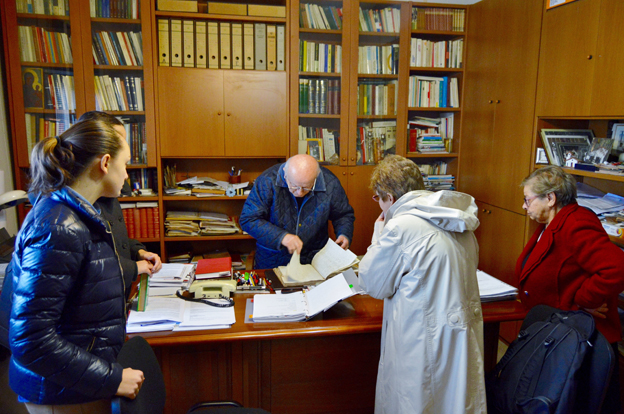
[Looking for records in Don Ivo's church.]
Did you discover any amazing story during the process of searching for your Italian relatives?
On my third trip to Italy, I was able to do research in the historical archives of Cento, L’Archivio Storico di Cento. Naturally, Diletta and Alicia were with me. We were just about finished when Mariateresa, the coordinator of services at the archives, walked by. She noticed one of the pages in a record book we had open. It was the same page Natalina, who lived in Cento, read only a couple of weeks ago. Natalina didn’t understand the details and left without the information she hoped to find. Mariateresa called her. Natalina, whom we did not know, arrived within fifteen minutes. We learned that her purpose in searching was to find relatives in the United States who were descendants of an immigrant uncle. We assured her we could help her find them. But wait, I had a set of old family photos that I believed were connected to this branch of the family. I only knew a couple of people in them and was sure they were taken in Italy. I hoped someone on this trip could identify everyone. We spread them out on the table. Natalina glanced through them. Quietly, she started to recite names and relationships among them. The people she identified as her family were linked to mine through a brother and a sister – Ruffillo Alberghini and Emiliana Alberghini. Natalina and I are first cousins once removed on the side of my Nonno’s father, Ruffillo, my great grandfather.
Now the excitement didn’t stop there. When I returned home I started the search for Natalina’s relatives. Through a variety of sources, I found her immigrant uncle and followed him to his current descendants. I found their names and potential addresses. I wrote a letter and mailed it, hoping to hear from them. Hear from them I did! Michael, Richard and Donna are my third cousins! They all live within easy driving distance from me. Whenever we are together, we have a grand time. Now we are more than cousins. We are friends for life.
Ultimately, what has the experience of reconnecting to your Italian roots meant to you?
My life has become enriched more than I ever could have imagined and the endearing relationships with my newly found cousins are at the heart of it all.
I committed to learning Italian. I wanted to understand and talk with my relatives. I wanted to fully experience life in Italy. After my first trip, I started studying their beautiful language with my brother, John. Although, I don’t know how beautiful my Italian is, I still speak with a Boston accent.
The affirming support of Raffaella led to the publication of my first book. A Letter to My Children: An Italian American Family’s Heritage began as my senior thesis in college and is based on the first 30 years of my research. It is dual language translated into Italian by Diletta, thus making it our book. It first launched in Renazzo in November 2016 hosted by the town’s Cultural Center. It was a very emotional day as the towns of my grandparents warmly embraced me. The experience deepened my connection to the past, grounded me in the present, and laid the foundation for future relationships and unknown possibilities.
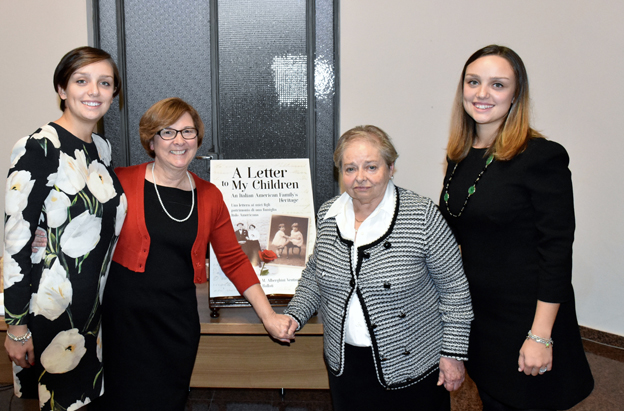
[At Laura's book launch.]
Research in Italy strengthened my conviction that keeping my ancestors alive through their stories acknowledges their place in history. I became fanatical all over again in studying my family’s past. Joined by Raffaella, Diletta, and Alicia we’ve uncovered an unbelievable amount of information. Each exciting research experience is a story unto itself. They are chronicled in a book I am now writing of my journey searching back through time for my Italian family.
I collaborated on the creation of an Italian online museum for immigration. Nulla osta per il mondo: museo digitale dell’emigrazione da Cento went live in January 2019 (https://www.memcento.it). A project of the historical archives, its purpose is to help both Americans and Italians with connections to the Cento district learn about their ancestors who immigrated to other countries and help families find each other. The online museum acknowledges that each of us lost some of our heritage when people immigrated to America and other countries. If you have family from the Cento district, please check it out. If you have an ancestor who immigrated to America and would like to submit a story about her or him, please email Rhonda McClure at rmcclure@nehgs.org.
By now you can tell Frank and I travel frequently to Italy. We generally make between one to three trips each year staying anywhere from 10 days to a month. Although we do some sightseeing, we mostly enjoy living the Italian daily life alongside my relatives. We often choose to go for holidays, a favorite is La Befana on the eve of the Epiphany; for particular family events such as the annual making of their sausage and salami; or special occasions like the re-opening of San Sebastiano’s church that was damaged in a 2012 earthquake. Frank and I are forever grateful for those ancestors who braved entering a new world in America and who led me to Italy and my Italian roots.
Thank you, Laura, for sharing your story.
